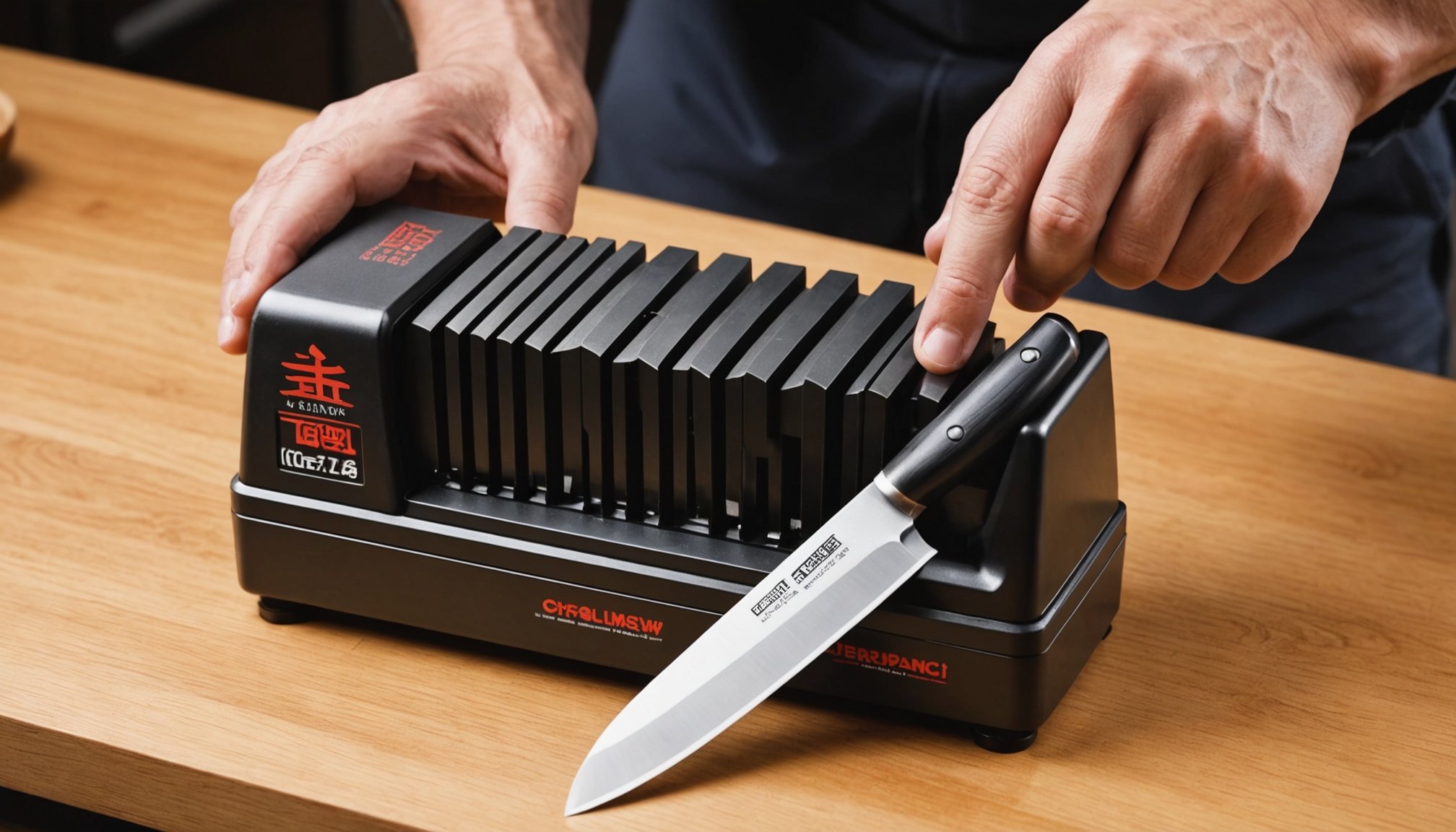Importance of Ceramic Knife Sharpeners for Japanese Knives
Japanese knives are renowned for their exceptional sharpness and precision, which is why maintaining their edge is essential. These knives often feature a harder steel that retains a fine edge longer. However, regular sharpening is necessary to preserve their performance and longevity.
Ceramic knife sharpeners offer several advantages over traditional methods. They are incredibly effective in preserving the blade’s integrity while achieving a razor-sharp finish. Unlike metal sharpeners, ceramic sharpeners are less likely to remove excess material from the blade, thus extending its lifespan. This is particularly beneficial for Japanese knives, which often have a more delicate edge.
Have you seen this : Essential Considerations for Selecting the Perfect Portable Ice Maker for Your Next Party
Proper sharpening with a ceramic sharpener can enhance both the longevity and performance of Japanese knives. Consistently sharp blades reduce the need for excessive force, improving control and precision in culinary tasks. This can lead to more enjoyable and efficient cooking experiences.
Understanding these benefits, integrating ceramic sharpeners into your knife maintenance routine can significantly elevate the performance of Japanese knives. By investing in proper sharpening tools, you’re ensuring these culinary instruments remain at their optimal condition, offering long-term benefits and enhancing your cooking experience.
Also read : Digital vs. Analog: The Best Kitchen Scale Choice for Aspiring Chefs
Importance of Ceramic Knife Sharpeners for Japanese Knives
Japanese knives are distinguished by their distinct craftsmanship and quality. The incorporation of a ceramic knife sharpener into your maintenance routine is essential for preserving these blades. Why are ceramic sharpeners beneficial for Japanese knives?
First, ceramic knife sharpeners cater to the unique hardness of Japanese knife steel, maintaining sharpness without over-grinding the edge. Metal sharpeners, by contrast, often remove excess material, reducing blade longevity. A ceramic sharpener’s fine abrasive surface gently hones the edge, safeguarding the knife’s delicate structure. This precision ensures sustained performance and heightened enjoyment in culinary tasks.
Moreover, using a ceramic sharpener regularly translates to enhanced knife performance. It upholds the delicacy and precision of Japanese knives by maintaining their sharp edge. This results in a seamless slicing experience, requiring less force, enabling you to execute cuts with confidence.
These sharpeners stand out because they ensure both the longevity and the effectiveness of Japanese knives. They not only protect the blade’s integrity but also amplify the cooking experience. Mastering the art of sharpening with ceramics allows you to maintain these unique tools in peak condition, offering an unrivaled, long-term advantage.
Top Ceramic Knife Sharpeners for Japanese Knives
Incorporating the best ceramic knife sharpeners into your routine is vital for maintaining Japanese knives at their peak performance. With many options available, selecting the right product can be challenging.
Product A Review
Product A stands out for its advanced features and user-friendly design. It offers multiple grit levels, enabling precision in sharpening various knife types. Users commend its ease of use and consistent performance. Priced reasonably, it represents good value, offering longevity benefits.
Product B Review
Product B excels with its durable construction and effective sharpening surfaces. Known for maintaining the delicate edge of Japanese knives, it is frequently praised in reviews for its seamless sharpening experience. While the price is slightly higher, its reliability justifies the investment for serious home chefs.
Product C Review
Product C combines simplicity with efficiency, making it ideal for beginners. Its straightforward setup and clear instructions contribute to positive user feedback. The pricing is competitive, providing accessibility without compromising on quality.
Choosing the right ceramic knife sharpener enhances the longevity and performance of Japanese knives, thereby enriching your culinary adventures. Each product offers distinct advantages, ensuring a tailored sharpening experience.
Techniques for Sharpening Japanese Knives
Mastering the art of sharpening techniques is crucial for maintaining your Japanese knives in optimal condition. A ceramic knife sharpener offers a proficient way to achieve a precise edge without compromising the blade’s quality.
Begin the sharpening process by placing the sharpener on a stable surface. Hold the knife at a consistent angle, typically between 15 to 20 degrees, catering to the specific knife type. Using a gentle and steady motion, slide the blade through the sharpener, ensuring even pressure throughout the stroke. Repeating this process maintains the blade’s razor-sharp finish.
To adjust sharpening angles, consider the knife’s design—narrower for finer tasks and broader for sturdier cuts. Practice is key in honing the ideal angle for each knife, as it varies between different knife styles.
Avoid common mistakes such as applying excessive force, which can lead to premature wear or uneven edges. Regular sharpening and maintaining the correct angle not only extend the knife’s lifespan but also enhance its performance, ensuring precise and effortless cuts. Embracing these expert tips will elevate your knife maintenance routine significantly.
Care and Maintenance of Japanese Knives
Proper knife care ensures the long-term performance of your prized Japanese knives. Incorporating a systematic approach to maintenance routines is key. Regular sharpening is crucial, with frequency depending on use; frequent users may sharpen weekly, while less frequent cooks could suffice with monthly sessions.
Cleaning and storing your knives correctly also contribute to longevity. After each use, handwash your knife with mild soap and water, avoiding the dishwasher to prevent potential damage. Dry immediately to prevent water spots or rust. For storage, invest in a magnetic strip or a knife block, keeping blades secluded from other utensils.
Japanese knife maintenance demands awareness of their high-quality construction, preventing accidental damage. Avoid cutting through bones or hard substances, which could compromise the blade’s integrity.
Awareness of these maintenance routines not only emphasizes the importance of care but also ensures each knife offers optimal performance. This attention to detail safeguards your investment, allowing you to enjoy the unparalleled precision and effectiveness of Japanese knives for years to come.

